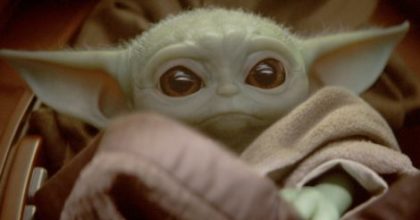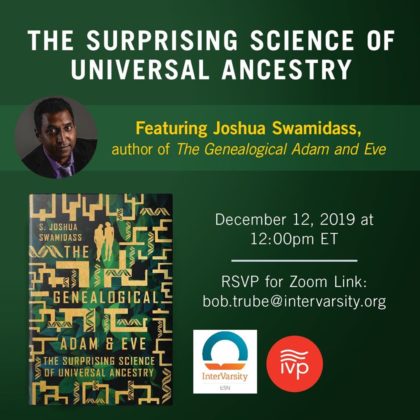
Large swaths of the Internet have fallen under the spell of Baby Yoda, and I guess I’m not immune to those charms either. (Yes, I recognize they’re not actually young Yoda, but the character doesn’t have an actual name and Baby Yoda has a satisfying lilt.) Actually, part of the charm is intrinsic to our biology and psychology as humans; certain features common to human babies, like big eyes and proportionately large heads, read as cute to nearly all of us across a variety of contexts. One might expect baby chimps and monkeys to elicit a paternal response, but even creatures like squids which have few features in common with mammals, or inanimate objects like Pop! vinyls, or puppets of fictional 50-year-old aliens can exploit our neural pathways to get an “Awww.”
But why do human babies look like that in the first place? Partly it has to do with the constraints of development and childbirth. But it may also have something to do with the domestication of humans. It is well understood that human domestication of other animals comes with a suite of morphological changes like floppy ears and pigmentation changes. There are also behavioral changes, which it is reasonable to presume were selected for. Were we also selecting, either consciously or unconsciously, physical traits that were more appealing in some fashion? Or are there developmental and genetic reasons why all of these traits come together?
Those questions have not been fully answered, but we can add a new wrinkle to the conversation. The idea has been proposed previously that humans were the first species we domesticated. The case can be made that we possess some of the physical and behavioral hallmarks of domestication. Now, new research has found evidence of positive selection in regions of our genome associated with regulating genes linked to facial structure development and social behaviors. The corresponding regions of genomes in apes and even Neanderthals do not show the same markers of selection, indicating that the selection occurred within the Homo sapiens lineage.
Now, if domestication did occur in humans, it wasn’t necessarily the same kind of intentional process that domesticated, say, cows. And we’re also not talking about the sort of domestication depicted in The Mandalorian, where the title character is changing his behavior because Baby Yoda is provoking his paternal instincts. Instead, the idea would be that less aggressive and/or more cooperative humans were more successful in staying alive and passing on their genes–maybe because they could be more successful hunting in groups, maybe because they were less likely to get killed in conflict with other humans, maybe some other factor or some combination of all of them. Whatever provided the selective pressure, the end result is a species that has more in common with a basket of puppies than a lone wolf.
Our ability to work together produces some pretty neat stuff, not least of which being the innovative technology being used to film The Mandalorian. Realtime video game engine rendering and LED light panels allow them to incorporate computer-generated scenery in the live action footage rather than replacing green screens later while also providing lighting on the actors and props which is appropriate for that environment. More theologically, these cooperative traits allow for the development of the kind of loving communities that God calls us to form.

While we’re talking about human prehistory and human origins, allow me to remind you that a new book on the topic of what it means to be human, how we evolved that way, and where Adam and Eve could fit into the process is now available. I’m talking about The Genealogical Adam and Eve by S. Joshua Swamidass. More importantly, Josh himself will be talking about it tomorrow, December 12, 2019 at 12pm EST. You will need to email bob.trube@intervarsity.org for the link to the webinar; get on that now so you can be part of the conversation tomorrow.
And on the subject of books, since it is Christmas shopping time for many, you might be interested in some recently published titles as gifts for others or to request as a gift for yourself. There’s The Work of His Hands, Sy Garte’s testimony of his conversion from atheism to Christianity and his answers to common questions about and arguments against the existence of God from a scientific perspective. Gregg Davdison’s Friend of Science, Friend of Faith tackles a variety of common topics like the age of the earth and Noah’s flood to show how a faithful reading of the Bible and a mainstream approach to science can be practiced together. A Worldview Approach to Science and Scripture by Carol Hill has a similar goal in mind but addresses the issues through the lens of worldviews. And don’t forget about Science & Faith, a compilation of essays from this very blog written in response to student questions and field tested with student discussion groups; that one is edited by Hannah Eagleson and includes contributions from a variety of scholars. Finally, you can still get Faith across the Multiverse, which largely sidesteps the common questions about science and the Bible and instead focuses on how the language & concepts of science can enrich our conversations about Christian beliefs. There’s also plenty of references to recent sci-fi films, books and movies, for those who enjoyed today’s Baby Yoda chat; that book is by me.
A bit of housekeeping: Next week I’ll attempt a bit of year end review, then I’ll take a brief holiday hiatus since Christmas and New Year’s fall on Wednesdays. I’ll be back on January 8, 2020 with more entries in the sci-fi film festival, reviews/discussion of some of the above-mentioned books, and more.
Andy has worn many hats in his life. He knows this is a dreadfully clichéd notion, but since it is also literally true he uses it anyway. Among his current metaphorical hats: husband of one wife, father of two teenagers, reader of science fiction and science fact, enthusiast of contemporary symphonic music, and chief science officer. Previous metaphorical hats include: comp bio postdoc, molecular biology grad student, InterVarsity chapter president (that one came with a literal hat), music store clerk, house painter, and mosquito trapper. Among his more unique literal hats: British bobby, captain’s hats (of varying levels of authenticity) of several specific vessels, a deerstalker from 221B Baker St, and a railroad engineer’s cap. His monthly Science in Review is drawn from his weekly Science Corner posts — Wednesdays, 8am (Eastern) on the Emerging Scholars Network Blog. His book Faith across the Multiverse is available from Hendrickson.

Leave a Reply